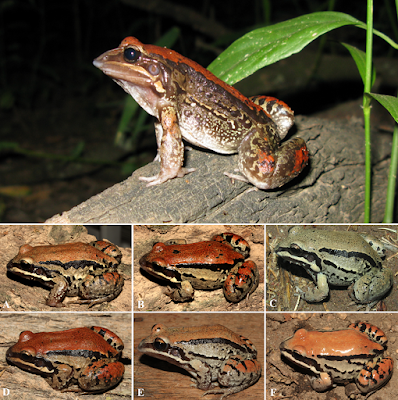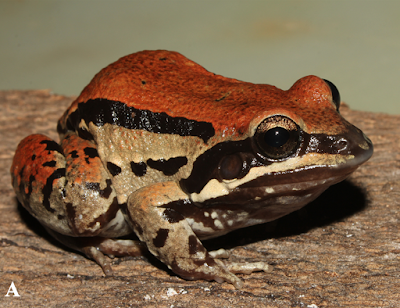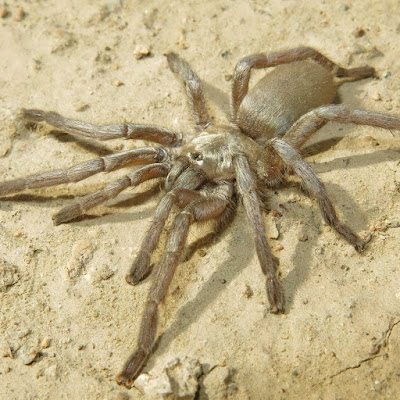[Most Recent Entries] [Calendar View]
Friday, October 11th, 2019
| Time | Event | ||||
| 3:31a | [Ichthyology • 2019] Upeneus caudofasciatus, U. gubal & U. heterospinus • Three New Goatfishes of the Genus Upeneus (Mullidae) from the Indo-Pacific, with A Redescription of Colour Patterns in U. margarethae
Abstract For the goatfish genus Upeneus Cuvier 1829 (Mullidae), a new taxonomic species group called the “margarethae group” is established which can be distinguished from the six species of the most similar “tragula group” by a combination of the following characteristics: absence of dark pigmentation in the area of the first dorsal-fin tip, 21–25 total gill rakers and 28–30 lateral-line scales. Initially, three recently-described species have been included in the margarethae group: Upeneus margarethae Uiblein & Heemstra, 2010, known from the Indian Ocean including the Red Sea and from the Arafura Sea (W Pacific), U. mouthami Randall & Kulbicki, 2006, from New Caledonia and Vanuatu (W Pacific), andU. randalli Uiblein & Heemstra, 2011, from the Arabian/Persian Gulf and the inner Gulf of Oman (NW Indian Ocean). The present taxonomic review of the margarethae group analyses a large data set of 41 morphometric, 10 meristic and many colour characters obtained from 279 preserved goatfish specimens and 166 fresh-colour photos (plus a fresh-colour drawing). For the nominal species of the group, U. margarethae, a redescription of the colour patterns is provided and new records for Myanmar, Andaman Sea (NE Indian Ocean) and the Gulf of Carpentaria, N Australia (W Pacific), are reported. Three new species are described: Upeneus caudofasciatus n. sp. from the area of the Great Barrier Reef to Torres Strait off NE Australia (Coral Sea, W Pacific), U. gubal n. sp. from the S Gulf of Suez (Northern Red Sea), and U. heterospinus n. sp. from S Indonesia to Singapore, the Gulf of Thailand, Vietnam, Philippines, China, Taiwan and Japan (W Pacific). A comprehensive alpha-taxonomic approach is adopted, considering population differences as well as intraspecific sizerelated variation in morphology and colour patterns by splitting the data set into two size classes, adults (≥ 65 mm SL) and smaller subadults. Inter- and intraspecific comparisons include statistical analyses for species and population with sufficiently large samples sizes (n ≥ 20). Colour-pattern characterization and analysis are based on photos of recently collected and deceased fish (partly associated with voucher specimens), photos obtained from active or resting fishes in situ or in a tank, and inspection of pigmentation patterns retained in preserved specimens. Species differences are elaborated under consideration of distribution patterns and the characteristics found in the closest-most population of widely distributed species such as U. margarethae, resulting in clear and consistent distinction among the six species in single or in a combination of several characteristics. Comparisons among size classes revealed species-specific patterns in morphometric, meristic and colour changes with increasing size. One species, U. heterospinus n. sp., has seven or eight spines in the dorsal fin which occur in balanced ratio across populations. This is a unique characteristic for Upeneus species which usually have either seven or eight dorsal-fin spines, respectively. The best distinction of Upeneus heterospinus n. sp. from all other congeners is reached by combined examination of dorsal-fin spines with several other characters such as barbel colour, presence of a mid-lateral body stripe, pigmentation patterns (partly retained also in preserved fish), gillraker and pectoral-fin ray numbers, and body-shape variables. The high degree of overall morphological differentation among the three most common species U. caudofasciatus n. sp., U. heterospinus n. sp. and U. margarethae, as revealed by the statistical comparisons, strongly contrasts with a still signficant, but much lower degree of differentiation among populations. The diagnostic characteristics of the margarethae group are updated and the importance to use the results of this taxonomic review in ongoing fisheries-related and ecological research is emphasized. Requirements for future taxonomic research featuring the stunning diversity of the goatfish genus Upeneus are also discussed. Keywords: Pisces, margarethae species group, meristic characters, body shape, colour patterns, comprehensive alpha taxonomy Upeneus margarethae Uiblein & Heemstra, 2010 Margaretha’s goatfish Upeneus caudofasciatus n. sp. Uiblein & Gledhill Tailbar goatfish Etymology. The name refers to the occurrence of oblique conspicuous bars which cross both caudal-fin lobes entirely. Distribution, habitat and size. SW Pacific, NE Australia, Queensland, from W of Thursday Island and S of Daru Island, Torres Strait to NE of Gladstone, Great Barrier Reef; maximum depth 60 m, commonly trawled above soft bottoms at between 15 and 40 m; maximum size 12.5 cm SL. Intraspecific comparisons. Subadults differ from adults in having a slightly longer head, shallower pelvic-fin depth and longer pelvic fins (Tables 2, 9; Figure 8); they differ in having fewer bars on the caudal fin (only preserved fish could be compared; Tables 2, 9); dark pigmentation is more often found in preserved subadults than in preserved adults (Tables 2, 9; see also preserved colour description above). Remarks. Because of the relatively small distribution area of the species and low numbers of specimens available from the most distant localities, no quantitative population comparisons could be conducted. In two of the 55 studied specimens the tiny first-dorsal fin spine is overgrown with skin or very small and hence difficult to detect. Though this species appears to be rather common on shallow soft bottoms near coral reefs, we could not find any in-situ fresh-colour photo documentation. Upeneus gubal n. sp. Uiblein Gubal goatfish Diagnosis. Dorsal fins VIII + 9, the first spine minute; pectoral fins 15; gill rakers 6 + 19 = 25; lateral-line scales 28–29; measurements in % SL: body depth at first dorsal-fin origin 24; body depth at anus 21; caudal-peduncle depth 11; caudal-peduncle width 3.3; maximum head depth 20; head depth through eye 16; suborbital depth 9.0; interorbital length 8.2; head length 29; snout length 11; postorbital length 11; orbit length 7.4; upper-jaw length 11; barbel length 19; interdorsal distance 16; caudal-peduncle length 24; caudal-fin length 31; anal-fin height 19; pelvic-fin length 22; pectoral-fin length 22; pectoral-fin width 4.8; first dorsal-fin height 22; second dorsal-fin height 19; preserved colour pale brown. Etymology. Named after the type locality which is situated close to Gubal Island and in the Strait of Gubal at the southern entrance to the Gulf of Suez, Northern Red Sea. The name “gubal” is used as a noun in apposition. Distribution, habitat and size. Single locality off Gubal Island, S Gulf of Suez, Northern Red Sea; fish caught by trawling at 70 m depth, most probably on sandy or muddy bottom; size of the specimen is 8.7 cm SL. Remarks. Fresh colour of Upeneus gubal n. sp. is yet unknown, but the available morphological evidence strongly suggests its inclusion in the margarethae group (see also the Interspecific comparisons section further below). The single type specimen was collected together with a specimen of Upeneus moluccensis (Bleeker, 1855) (registered as MNHN 2011-0093). The latter did not show any remains of dark pigmentation e.g. of first dorsal-fin tip and oblique bars on upper caudal-fin lobe as indicated to be diagnostic for preserved conspecifics (Uiblein & Heemstra 2010). The single known locality of U. gubal n. sp. in the S Gulf of Suez is about 1100 km north of the northernmost currently known occurrence of U. margarethae off Ibn Abbas Island, S coast of Sudan. Upeneus heterospinus n. sp. Uiblein & Pavlov Varied-spine goatfish Etymology. The name refers to the variable number of 7 or 8 dorsal-fin spines in this species, which is in contrast to most other goatfish species and all other Indo-Pacific congeners which have either 7 or 8 dorsal-fin spines. Distribution, habitat and size. W Pacific, from border to EIO in S Indonesia to Singapore, Gulf of Thailand, Vietnam, Central Philippines, South China, Taiwan, and S Japan; 6–24 m depth, sandy or muddy bottoms; maximum size 16 cm SL. Intraspecific comparisons. To ensure that the dimorphic expression of seven and eight dorsal-fin spines in U. heterospinus n. sp. is indeed a single-species characteristic, as is unusual in goatfishes, the two morphs were compared using the entire set of studied characters. As was expected, no differences could be discovered in any single character (Table 8), nor in any combinations of characters or in statistical comparisons of morphometric, meristic and colour characters. ... Remarks. Upeneus heterospinus n. sp. has been reported from many areas using various names and most recently as U. spottocaudalis from Japan (Bandai et al. 2018). From Vietnam, where it is a common species that is frequently encountered in fish markets, biological data have been recently collected and published using preliminary identification information (Emel’yanova & Pavlov 2014; Pavlov & Emel’yanova 2016). Upeneus mouthami Randall & Kulbicki, 2006 Mou Tham’s goatfish Distribution, habitat and size. Coral Sea, New Caledonia, Chesterfield Islands and Vanuatu off Malo and Spiritu Santo Islands; 36–175 m depth, muddy bottoms, adults occur shallower than juveniles; maximum size 9.5 cm SL. Intraspecific comparisons. Subadults differ from adults in shallower head, narrower snout, slightly longer caudal peduncle and first dorsal-fin base, longer caudal fin and narrower pectoral fins (Tables 2, 9). Upeneus randalli Uiblein & Heemstra, 2011 Randall’s goatfish Intraspecific comparison. The single subadult differs from adults in shallower maximum body and head depth, shallower caudal peduncle, shallower suborbital depth, larger eyes, longer anal-fin base, slightly narrower pectoral fins and wider bars on caudal fin, especially on lower fin lobe which is crossed by a dark stripe at mid of lobe (Tables 2, 9; Figure 2 G, H). Franz Uiblein, Daniel C. Gledhill, Dimitri A. Pavlov, Tuan Anh Hoang and Shaker Shaheen. 2019. Three New Goatfishes of the Genus Upeneus (Mullidae) from the Indo-Pacific, with A Redescription of Colour Patterns in U. margarethae. Zootaxa. 4683(2); 151–196. DOI: 10.11646/zootaxa.4683.2.1 | ||||
| 3:10p | [Herpetology • 2019] Leptodactylus apepyta • A New Frog of the Leptodactylus fuscus Species Group (Anura: Leptodactylidae), endemic from the South American Gran Chaco
Abstract A new species of Leptodactylus frog (Anura: Leptodactylidae) from the South American Gran Chaco, morphologically similar and previously confused with the widespread Leptodactylus mystacinus, is described through the use of multiple sources of evidence (molecular, external morphology, coloration, osteology, bioacoustics, and behavior). The phylogenetic analysis with partial sequences of mitochondrial rDNA genes (12S and 16S) recovered the new species within the L. fuscus group, being highly divergent (>3% genetic distance in 16S). The new species was recovered as sister taxa of L. mystacinus, from which it is distinguished by tympanum coloration, cephalic index, dorsum and legs coloration, and some osteological differences in nasals and prevomers. This new frog is characterized by a moderate body size (SVL 46.80–66.21 mm), distinctive color pattern (reddish dorsal surfaces of body with noticeable black stripes in the dorsolateral folds), a circular and dark tympanum with dark tympanic annuli, and behavior of males that call on top of fallen logs and tree branches close to the ground.
Leptodactylus apepyta sp. nov. Etymology: The specific epithet is an indeclinable noun, constructed from the words of the Guaraní language apé (= back of the neck, dorsum) and pytã (= red), in reference to the intense brick red dorsum of adult and juvenile live specimens. Leptodactylus apepyta sp. nov. is assigned to the L. fuscus group (sensu Heyer (1969b)) by its phylogenetic position, and by the presence of the following synaphomorphies (Ponssa, 2008): (1) tectum nasi and alary process of premaxilla at the same level; (2) frontoparietal with posterior margin convex, and (3) cultriform process of parasphenoid sited between neopalatines. The new species is diagnosed within the L. fuscus group by the following combination of character states: (1) moderate size sensu Heyer & Thompson (2000) (SVL 46.80–61.41 mm in males; 51.67–66.21 mm in females); (2) robust body aspect in dorsal view; (3) head wider than long (CI 0.77–0.95); (4) small, circular, and dark tympanum, with dark tympanic annuli; (5) black broad stripe from tip of snout to the insertion of the forelimb; (6) a distinct light upper lip stripe; (7) one or two pairs of dorsolateral folds, with distinct uninterrupted dark stripes coincident with the upper pair, and interrupted dark stripes in the dorsolateral folds of the flanks; (8) reddish color on dorsal surfaces of body and limbs; (9) dorsum with small dark spots; (10) thigh, tibia, and tarsus with broad, diffuse, and dark bars; and (11) advertisement call composed by a single, short (30–68 ms), and non-pulsed note; call rate of 3.86–7.69 calls/s, without harmonic structure and with dominant frequency between 2,155 and 2,457 Hz; (12) males usually call on the top of fallen logs and low branches of trees. Rosio G. Schneider, Dario E. Cardozo, Francisco Brusquetti, Francisco Kolenc, Claudio Borteiro, Célio Haddad, Nestor G. Basso and Diego Baldo. 2019. A New Frog of the Leptodactylus fuscus Species Group (Anura: Leptodactylidae), endemic from the South American Gran Chaco. PeerJ. 7:e7869. DOI: 10.7717/peerj.7869 | ||||
| 3:27p | [Arachnida • 2019] Taxonomy of the Genus Ischnocolus (Araneae: Theraphosidae) in the Middle East, with Description of A New Species, I. vanandelae, from Oman and Iran
Abstract Spider material collected from Oman and Iran revealed a new species of the genus Ischnocolus Ausserer, 1871, which is described as Ischnocolus vanandelae sp. n. New records of I. jickelii L. Koch, 1875 from Saudi Arabia, Yemen and United Arab Emirates show a larger distribution of this species than previously known. The natural history of I. vanandelae sp. n. and I. jickelii is described and the rather unusual colour polymorphism of the latter is discussed. The genus now includes eight species, whose distribution is mapped. Keywords: Taxonomy, spiders, Mygalomorphae, Oman, Saudi Arabia, United Arab Emirates Family Theraphosidae Thorell, 1869 Subfamily Ischnocolinae Simon, 1892 Genus Ischnocolus Ausserer, 1871 Ischnocolus ignoratus Guadanucci & Wendt, 2014 Ischnocolus jickelii L. Koch, 1875
Ischnocolus vanandelae sp. n. Montemor, West & Zamani Etymology. This species is named after Mrs. Priscilla M. J. van Andel, a Dutch wildlife enthusiast, who, along with her husband Mr. J. H. (Hans) Raaijmakers, first found and provided specimens from the UAE for this study. Distribution. Oman, Iran (first record of the family). Vivian M. Montemor, Rick C. West, Alireza Zamani, Majid Moradmand, Volker V. Wirth, Ingo Wendt, Siegfried Huber and José Paulo L. Guadanucci. 2019. Taxonomy of the Genus Ischnocolus in the Middle East, with Description of A New Species from Oman and Iran (Araneae: Theraphosidae). Zoology in the Middle East. DOI: 10.1080/09397140.2020.1675994 |
| << Previous Day |
2019/10/11 [Calendar] |
Next Day >> |










